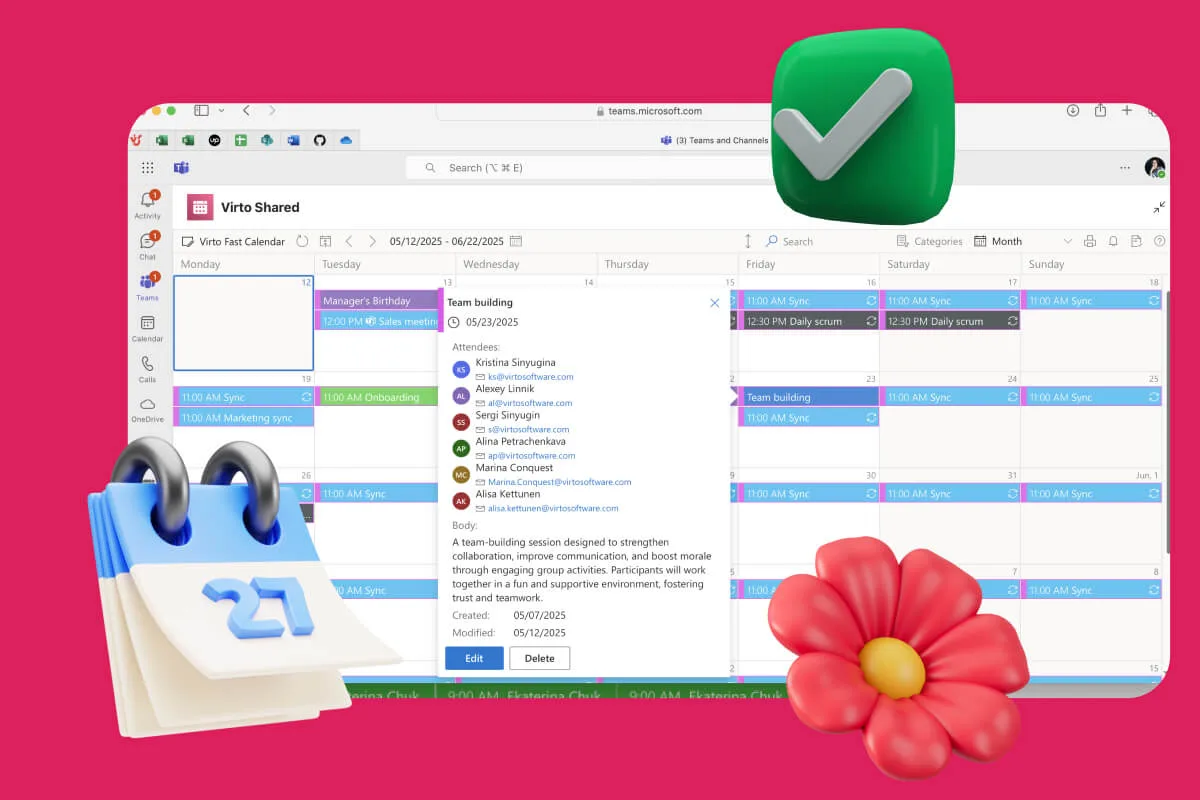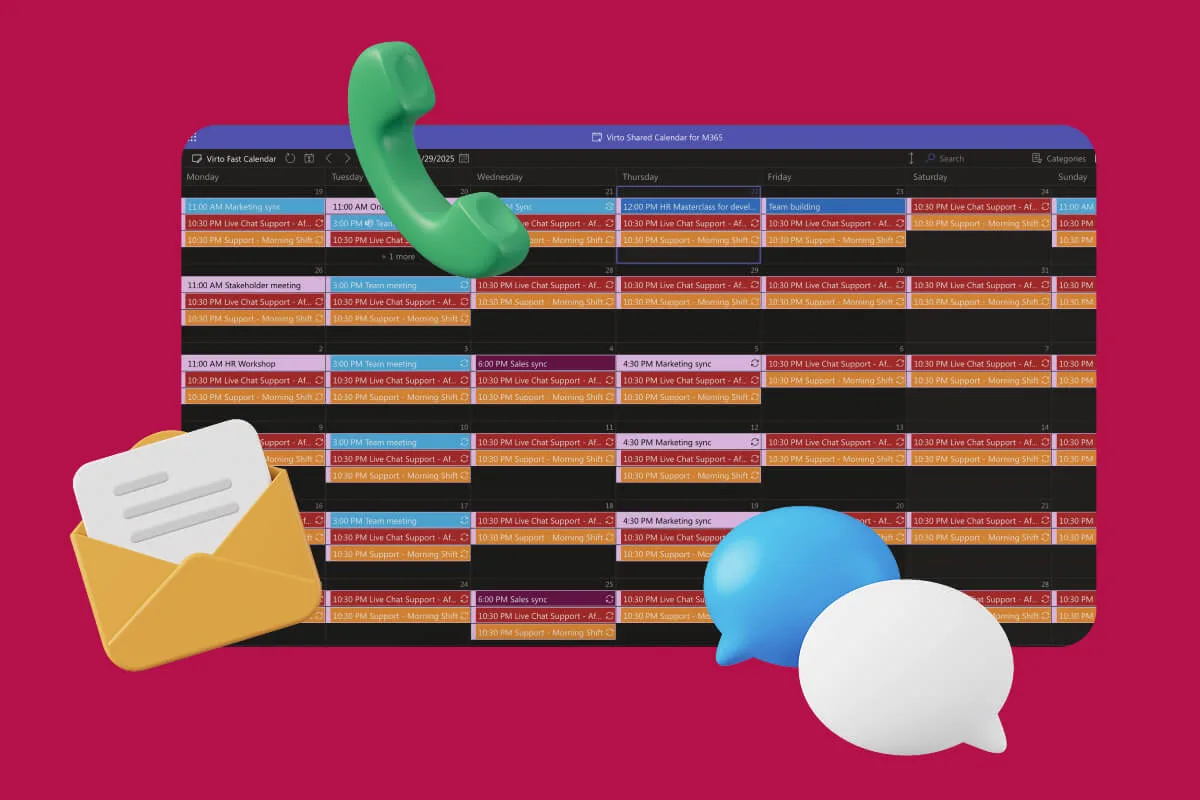Running a small business means juggling a million moving parts—and if your team’s calendar situation is a hot mess, everything else falls apart pretty quickly. Sound familiar? You’re definitely not alone.
Here’s the thing: Microsoft Teams has become the go-to hub for most SMBs, but when it comes to calendars, the standard setup often leaves small business owners scratching their heads. Sure, the new Teams calendar looks sleek and integrates nicely with Outlook, but what happens when you need to book meeting rooms, share schedules with external clients, or give your remote team a crystal-clear view of who’s available when?
That’s where things get interesting. While Teams’ native calendar handles the basics pretty well, there’s a whole world of third-party calendar apps designed specifically to fill those gaps—and some of them are absolute game-changers for small businesses.
We know it can seem overwhelming — that’s why we’ve done the research for you. We’ve gathered the top solutions available and broken down everything you need to know about Teams calendars for SMBs in 2025, including:
- First, we’ll dig into what small businesses actually need from a Teams calendar—think simple interfaces, affordable pricing, rock-solid integrations, and features that don’t require a PhD to figure out.
- Then, we’ll give you the honest truth about the standard Teams calendar—what it does well, where it falls short, and why many SMBs end up looking for alternatives.
- Next comes the good stuff: a deep dive into the top 10 Teams calendar solutions for small business, including heavy-hitters like Virto Shared Calendar, Calendar Pro, and Calendly for Teams. For each one, we’ll cover the key features, real-world use cases, limitations, pricing, and who should actually consider using it.
- Finally, we’ll help you choose the right solution with a practical decision framework—no fluff, just straight answers about which calendar app makes sense for your specific business needs.
Without further ado, let’s dive in and find the perfect Teams calendar solution for your business.
What Small Businesses Actually Need from a Teams Calendar
Before we jump into comparing specific apps, let’s get real about what small business owners and their teams are actually looking for in a calendar solution. We’ve talked to countless SMBs, and while their industries might be different, their calendar pain points are surprisingly similar.
Here’s what matters most when you’re running a lean operation where every minute (and every dollar) counts:
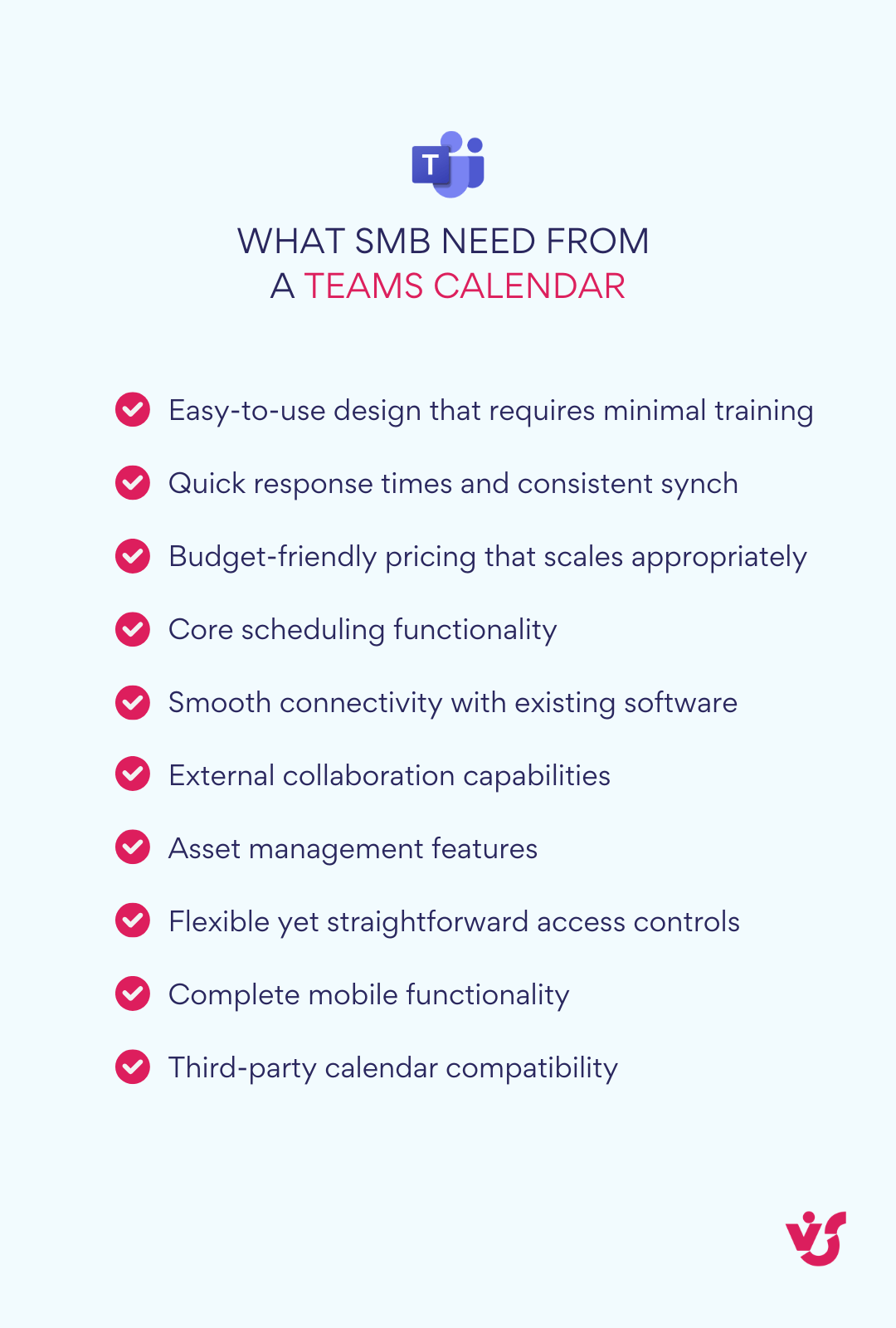
Simple, intuitive interface for quick onboarding
Small businesses don’t have the luxury of spending weeks training staff on complicated software. Your calendar app needs to be the kind of tool where someone can jump in and start creating events within minutes, not hours.
Think about it—when you’re onboarding a new team member or trying to get a client comfortable with your booking system, the last thing you want is a clunky interface that requires a manual thicker than a phone book. The best SMB calendar solutions feel familiar from day one, with clean layouts and logical navigation that just makes sense.
Fast performance and reliable syncing
Nothing kills productivity faster than a calendar that takes forever to load or shows different information to different team members. Small businesses need calendar apps that sync in real-time across all devices and platforms—whether someone’s checking the schedule on their phone during a commute or updating it from their laptop at home.
When your marketing manager adds a client meeting at 2 PM, your project manager needs to see that update immediately, not discover it during a scheduling conflict later. Reliability isn’t just nice to have—it’s make-or-break for busy teams.
Affordable pricing with free or scalable options
Let’s be honest: small business budgets are tight. You need calendar solutions that either offer robust free tiers or pricing that scales sensibly as your team grows. Paying enterprise-level fees for features you’ll never use? That’s not happening.
The sweet spot for most SMBs is either a free solution that covers the basics really well, or affordable paid plans that unlock advanced features without breaking the bank. Bonus points if you can start free and upgrade gradually as your needs evolve.
Essential features that actually get used
Small businesses have told us over and over which calendar features they can’t live without:
- Shared calendars that give everyone visibility into team schedules
- Resource booking for meeting rooms, equipment, or vehicles
- Color-coding to quickly distinguish between projects, clients, or event types
- Recurring events because nobody wants to manually create the same weekly meeting 52 times
- Mobile access for teams that are always on the go
- Smart notifications that keep everyone in the loop without becoming spam
Notice what’s missing from that list? Overly complex features that look impressive in demos but never get used in real life.
Seamless integration with business tools
Your calendar shouldn’t exist in a vacuum. Small businesses need solutions that play nicely with the tools they’re already using—especially Outlook (since most SMBs live in Microsoft 365), SharePoint for document management, and other productivity platforms.
The goal is to create workflows, not workarounds. When your calendar integrates smoothly with your existing business tools, scheduling becomes part of your natural workflow instead of a separate task that disrupts everything else.
Support for external users and cross-organization sharing
Here’s where many calendar solutions fall flat for small businesses: they’re built for internal use only. But SMBs constantly need to coordinate with clients, vendors, freelancers, and partners who might be using completely different systems.
The ability to share calendars with external users—even those without Microsoft accounts—is crucial. Whether it’s letting a client book appointments directly, coordinating with a contractor’s schedule, or sharing project timelines with stakeholders, your calendar needs to work beyond your organization’s boundaries.
Cross-organization sharing shouldn’t require jumping through technical hoops or forcing external users to create new accounts just to see when you’re available.
These aren’t just nice-to-have features—they’re the foundation of what makes a Teams calendar actually useful for small businesses. Keep these needs in mind as we explore the different solutions available, because the best calendar app is the one that checks all these boxes for your specific situation.
Why the Standard Teams Calendar Falls Short for Many SMBs
Microsoft has made some serious improvements to the Teams calendar lately, and we’d be lying if we said it wasn’t getting better. The new version is actually pretty impressive compared to what we had before. But here’s the reality check: even with all these upgrades, many small businesses still find themselves hitting walls when they try to use it for their day-to-day operations.
Let’s break down what’s working, what’s not, and why so many SMBs end up looking for alternatives.
What Microsoft got right with the new Teams calendar
Credit where credit’s due—Microsoft has really stepped up their game with the new Teams calendar. The new calendar integrates the Outlook calendar into Teams, offering a single, cohesive calendar experience that brings some genuinely useful features to the table.
Here’s what’s actually working well in the updated version:
- Unified experience with Outlook: Outlook features coming to Teams include delegate access, print support, expanded calendar settings, filtering, support for multiple time zones, time suggestions in scheduling, support for attachments, and more. This is huge for businesses that live in both platforms.
- Enhanced viewing options: Month View: View your calendar by month, a highly requested feature, especially useful for users with sparse calendars. Split View: When more than one calendar is selected, you can now split the calendar into two independent views. Plus you get customizable time scales and saved views—features that SMBs have been asking for.
- Copilot-powered intelligence: The integration of Copilot and Places technologies further enriches the calendar’s functionality, making scheduling more intelligent and context-aware. Copilot capabilities like managed booking are available in the new calendar experience, which can help automate some of the tedious scheduling work.
- Places integration: Places capabilities like recommended in-office days, Places finder, and Places card are all available in the new Teams calendar experience. This is particularly valuable for hybrid teams figuring out when to be in the office together.
- Improved meeting creation: Easily schedule meetings and events of all types from the new calendar with a more intuitive interface and better scheduling assistant features.
Where the standard Teams calendar hits a wall
But here’s where things get real for small businesses—even with all these improvements, the native Teams calendar still can’t handle some pretty basic SMB needs.
- Limited resource booking: While you can book basic meeting rooms, the standard Teams calendar doesn’t offer the kind of robust resource management that many small businesses need. Want to book equipment, vehicles, or manage complex scheduling across multiple resources? You’re out of luck without third-party help.
- Weak permission controls: The granular permission management that SMBs often need—like letting certain team members view but not edit schedules, or giving external partners limited access to specific calendar views—just isn’t there in the depth most businesses require.
- Multi-calendar management struggles: Sure, you can view multiple calendars, but managing multiple team calendars, department schedules, or project-specific timelines in a way that makes sense for small business workflows? The native solution feels clunky compared to specialized tools.
- Custom views and workflows: Every small business operates differently, but the Teams calendar offers limited customization for team-specific workflows. Color-coding is basic, custom fields are non-existent, and creating views that actually match how your business works often requires workarounds.
External integration limitations
Perhaps the biggest limitation for SMBs is how the standard Teams calendar handles external users and cross-organization sharing. While you can share calendars within your Microsoft 365 organization, seamlessly coordinating with clients, vendors, or partners who use different systems remains a challenge.
Need to let a client book appointments directly? Want to share project timelines with a contractor who doesn’t have Microsoft accounts? Planning to coordinate schedules across multiple organizations? The native Teams calendar makes these common SMB scenarios surprisingly difficult without additional tools or complex workarounds.
Don’t get us wrong—the new Teams calendar is a massive improvement and genuinely works well for many small business scenarios. But if your SMB needs more than basic internal scheduling, you’ll quickly discover why so many businesses turn to specialized calendar apps. The good news? There are some excellent options that fill these gaps perfectly.
Top Microsoft Teams Calendar Apps for Small Business in 2025
Now for the main event—let’s dive into the specific calendar solutions that are actually making a difference for small businesses in 2025. We’ve tested, researched, and talked to real SMBs about what’s working (and what isn’t) across the most popular Teams calendar apps.
Each solution below gets the full breakdown: what it does best, where it falls short, real-world use cases, and honest pricing info. No marketing fluff—just the straight story about which calendar apps are worth your time and which ones you can skip.
Microsoft Teams Native Calendar by Microsoft
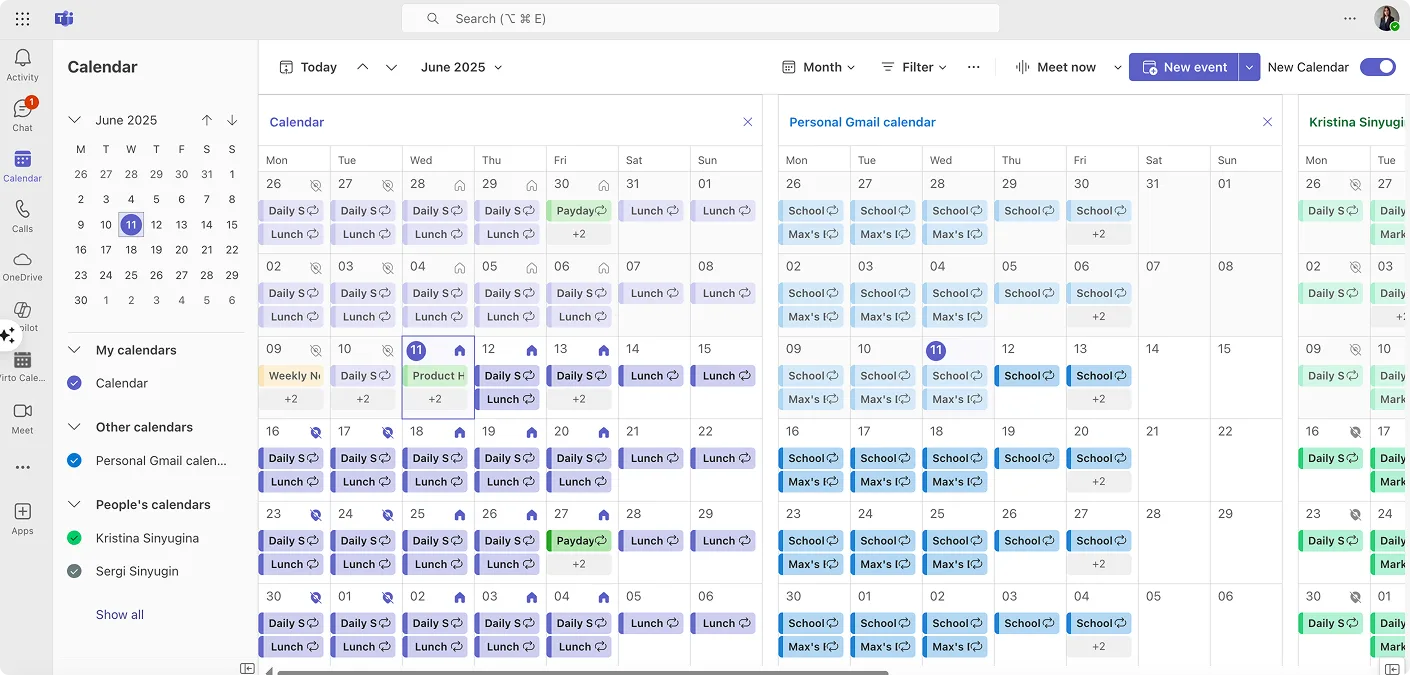
The baseline everyone’s comparing against. The new calendar integrates the Outlook calendar into Teams, offering a single, cohesive calendar experience with significant improvements over the old Teams calendar.
Key features:
- Unified Outlook integration: Month View: View your calendar by month, a highly requested feature, especially useful for users with sparse calendars. Split View: When more than one calendar is selected, you can now split the calendar into two independent views
- Copilot-powered intelligence: The integration of Copilot and Places technologies further enriches the calendar’s functionality, making scheduling more intelligent and context-aware
- Enhanced views and settings: Customize your calendar settings, including start and end times for events, location settings, and more. You can also share your calendar with others in your organization and print your entire calendar
SMB use scenarios:
- Internal team meetings: Perfect for basic scheduling across departments with automatic Teams integration
- Hybrid work coordination: Places integration helps teams figure out optimal office days
Limitations:
- Weak resource management: Can’t handle complex equipment or room booking scenarios
- Limited external sharing: Sharing with clients or partners outside your org is clunky
Pricing: Included with Microsoft 365 subscriptions
Best for: SMBs already invested in Microsoft 365 who need basic internal scheduling with minimal setup
👉 Learn more about the new calendar experience in Teams here: Get started with the new calendar in Microsoft Teams
Virto Shared Calendar by VirtoSoftware: Best Teams calendar app for SMB
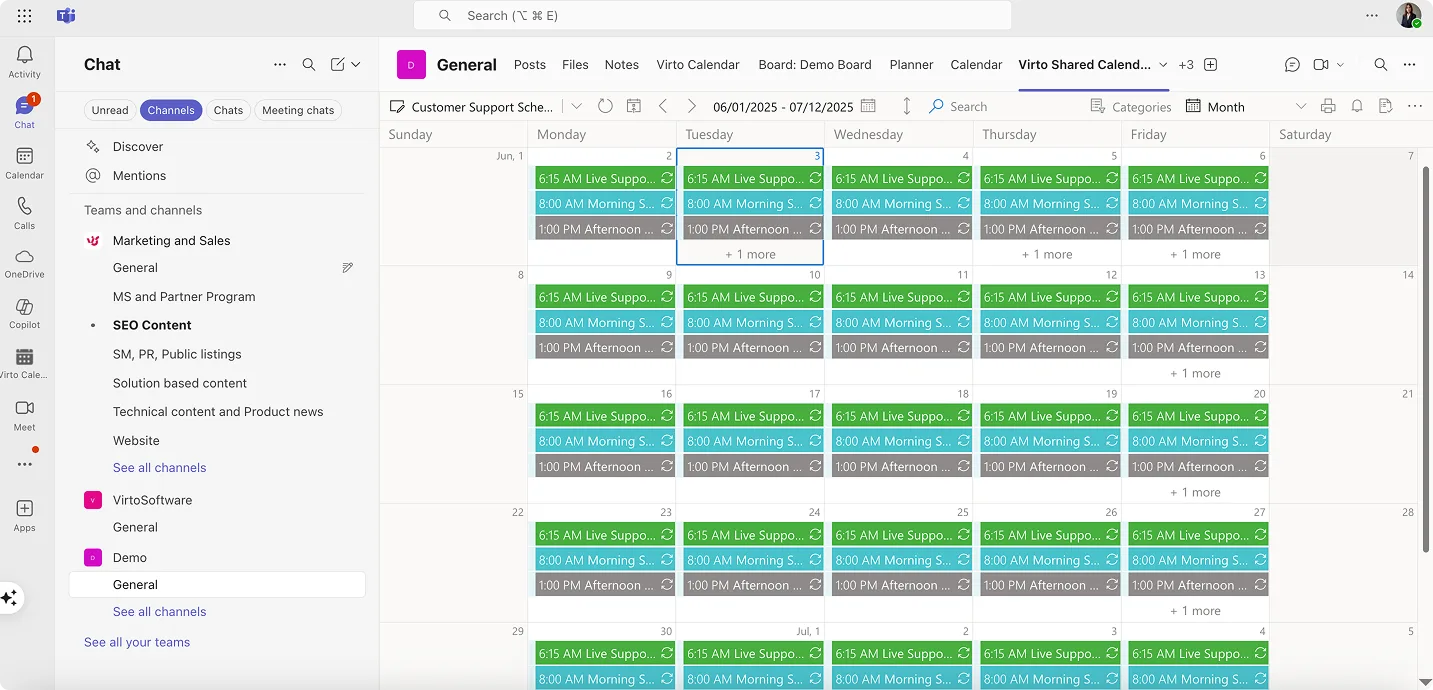
The new kid on the block that’s actually solving problems other solutions ignore. Built specifically for simplicity and universal access.
Key features:
- Anonymous access: Share calendars with anyone without requiring Microsoft accounts—huge for client-facing SMBs
- Cross-platform availability: Works natively in Teams or as a standalone web app
- Simplified event management: One-click event creation with color-coded tags, no complex overlays
SMB use scenarios:
- Client project coordination: Share timelines with clients who don’t have Microsoft accounts
- Vendor management: Coordinate schedules with external contractors seamlessly
Limitations:
- No calendar overlays: By design—focuses on simplicity over complex integrations
- New to market: Less established track record compared to older solutions
Pricing: $15/month for teams under 20 users, $299/year for unlimited users
Best for: SMBs that prioritize ease of use and need to collaborate frequently with external users without account hassles
👉 Learn more about Virto Shared Calendar here: Virto Shared Calendar App for Microsoft Teams
Explore All VirtoSoftware’s Scheduling Solutions
Shared Calendar in Teams by Cherryware GmbH

With over 300,000 installations, both the Project Plan app and Shared Calendar app are ranked among the top 20 most used apps in Microsoft Teams worldwide—there’s a reason it’s popular.
Key features:
- Multiple calendar views: Monthly, Weekly, Daily, Agenda and Timeline views
- Multi-platform mirroring: Mirror the same synced calendar in Microsoft Teams, SharePoint and Confluence
- Zero setup required: No setup or login needed! Avoid cluttering personal calendars: This is a separate calendar
SMB use scenarios:
- Project management: Perfect for milestone tracking without formal invitations
- Department coordination: Keep teams aligned on deadlines and events
Limitations:
- 15-event free limit: Shared Calendar for Microsoft Teams can be used for free for up to 15 calendar entries
- Limited advanced features: Focused on simplicity over complex scheduling
Pricing: Free for up to 15 events, paid licenses for larger calendars with volume discounts
Best for: Small teams needing straightforward shared calendars without the complexity of personal calendar invitations
👉 Learn more on the app here: Cherryware.com
Calendar Pro by Witivio
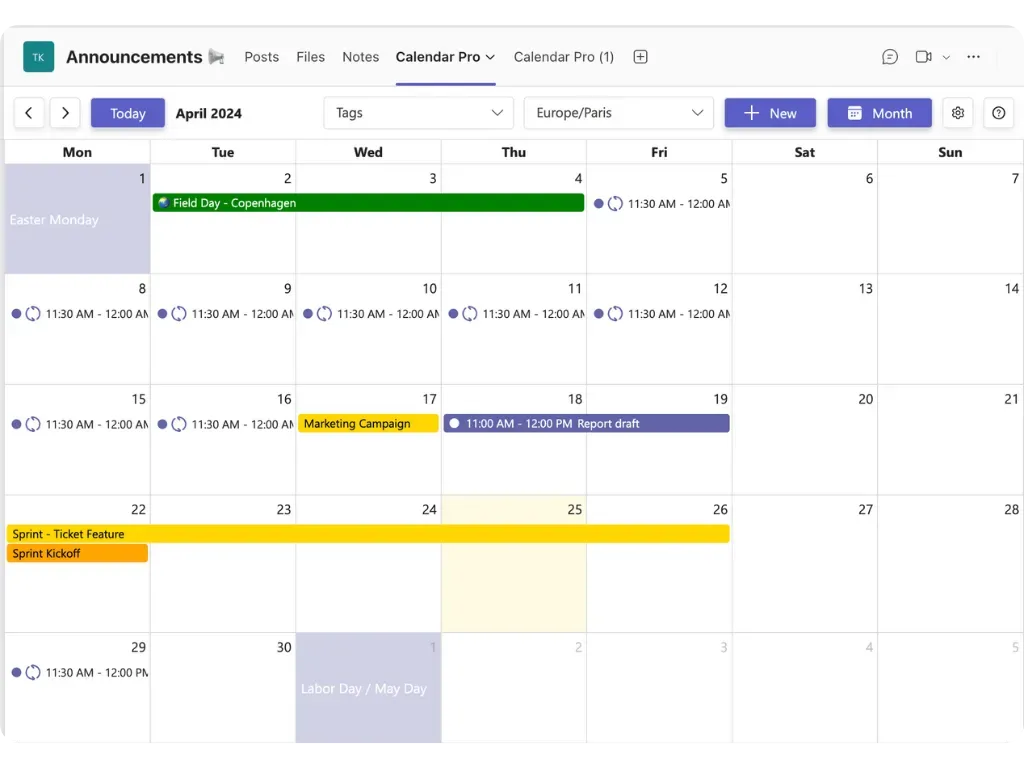
The powerhouse for SMBs that need serious resource management capabilities.
Key features:
- Advanced resource booking: In this calendar, you can list resources (rooms or objects) and book them
- Power Automate integration: Calendar Pro integrates seamlessly with Microsoft Teams, providing advanced calendar management features such as event creation, notifications, custom business days, and synchronization with other calendar services
- Customizable business rules: Customize business days, tags, and locations
SMB use scenarios:
- Meeting room management: Meeting room reservation: companies with a limited number of meeting rooms
- Equipment scheduling: Perfect for companies managing shared assets like vehicles or equipment
Limitations:
- Steeper learning curve: More complex setup compared to simpler alternatives
- Higher price point: Premium features come with premium pricing
Pricing: $0.49–$0.69 per user per month, depending on the size of your team
Best for: SMBs with complex resource booking needs who want powerful automation capabilities
👉 Learn more about Calendar Pro here: Calendar Pro.
Channel Calendar (Teams Store) by Microsoft

Microsoft’s attempt at channel-specific scheduling—decent for basic project calendars.
Key features:
- Channel integration: Dedicated calendars for specific Teams channels
- Project focus: Designed for project-based or departmental scheduling
- Native Teams experience: Fully integrated into Teams interface
SMB use scenarios:
- Project timelines: Keep project-specific dates visible to relevant team members
- Department events: HR, marketing, or IT can maintain their own calendars
Limitations:
- Limited functionality: Basic features compared to third-party alternatives
- Poor external sharing: Doesn’t handle client or vendor coordination well
Pricing: Included with Teams
Best for: Teams needing simple, project-specific calendars without external collaboration requirements
👉 Learn more about channel calendars in our dedicated article: How to Use and Manage Microsoft Teams Channel Calendar
Calendly for Microsoft Teams by Calendly, LLC
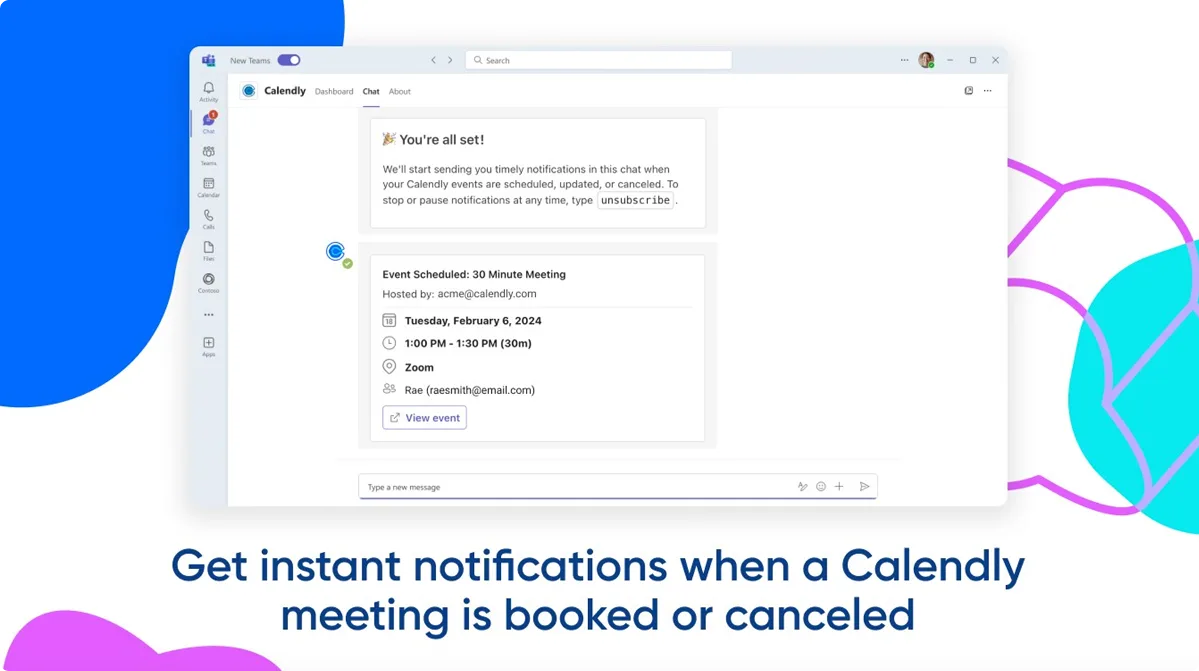
The appointment booking champion that plays surprisingly well with Teams.
Key features:
- Automated scheduling: Make it easy to connect virtually by integrating Calendly with Microsoft Teams Video Conferencing to automatically create a new Teams meeting every time someone schedules with you
- Teams integration: Automatically generate unique Teams video conference details for every new meeting you schedule
- Smart notifications: You’ll receive automatic notifications when a Calendly meeting is scheduled, rescheduled, or canceled, so you stay updated on your meetings without ever leaving Teams
SMB use scenarios:
- Client appointments: Perfect for consultants, lawyers, or service providers booking client meetings
- Sales demos: Streamline prospect scheduling with automatic Teams meeting creation
Limitations:
- External tool: Requires separate Calendly subscription and setup
- Limited team features: Primarily designed for individual scheduling
Pricing: Calendly costs $12/month, or $20/month per user for teams
Best for: SMBs focused on external appointment booking who want professional scheduling automation
👉 Learn more about Calendly for Teams here: Calendly for Teams
CalendarBridge by CalendarBridge, Inc.

The sync specialist for multi-platform organizations.
Key features:
- Cross-platform syncing: Connects Outlook, Google Calendar, and other platforms
- Universal integration: Handles complex calendar ecosystems
- Real-Time Updates: Keeps all platforms synchronized
SMB use scenarios:
- Multi-platform teams: Teams using mix of Google Workspace and Microsoft 365
- Client coordination: Sync with clients regardless of their calendar platform
Limitations:
- Complexity: Setup can be involved for simple use cases
- Sync Delays: Not always instant across all platforms
Pricing: Varies by configuration and user count
Best for: SMBs managing complex multi-platform calendar environments
👉 Learn more about CalendarBridge here: CalendarBridge.com
Teamup Calendar by Teamup Solutions AG
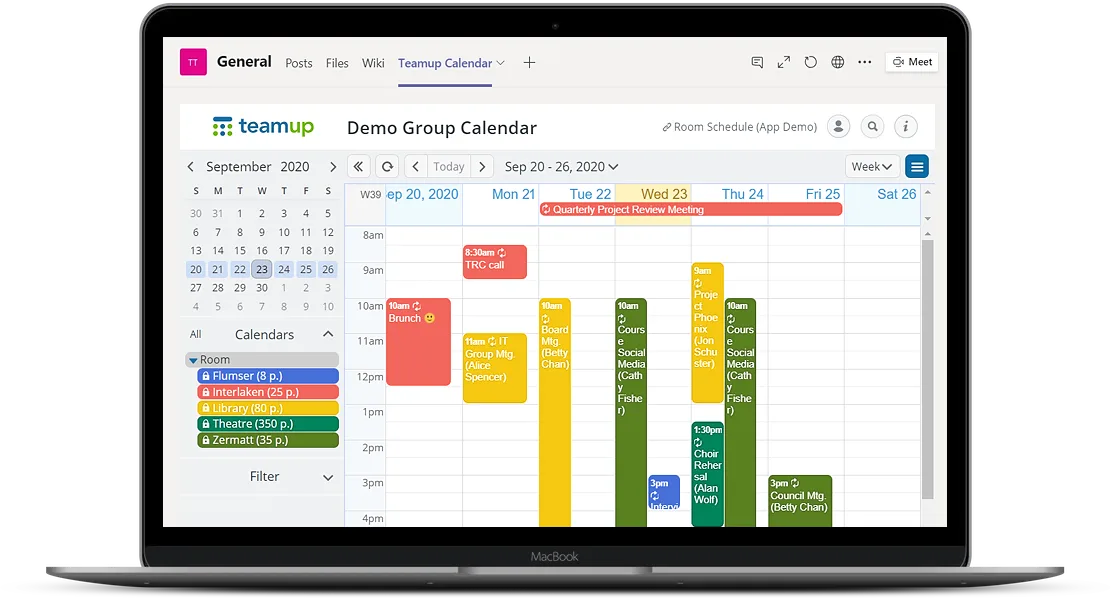
Teamup simplifies the messy work on managing schedules, availability, and information across many moving parts. It’s scalable, customizable, and powerful
Key features:
- Flexible permissions: Customize access permissions for optimal information visibility and privacy
- Multiple views: Teamup supports 11 calendars views… Day/Multi-day/Week/Multi-week/Month/Agenda/List views… Scheduler view, Timeline view, Table view and Year view
- Teams integration: Simply add your Teamup calendar as a tab to your Teams
SMB use scenarios:
- Resource management: Enable self-booking and keep central access control: no risk of unwanted alteration to existing bookings
- Multi-department coordination: Great for organizations needing different permission levels
Limitations:
- External platform: Not native to Teams ecosystem
- Learning curve: Powerful features require time investment
Pricing: Free tier available, paid plans for advanced features
Best for: Organizations needing highly customizable calendars with sophisticated permission controls
👉 Learn more about TeamUp calendar here: Teamup.com
Avista Shared Calendar by Avista Solutions
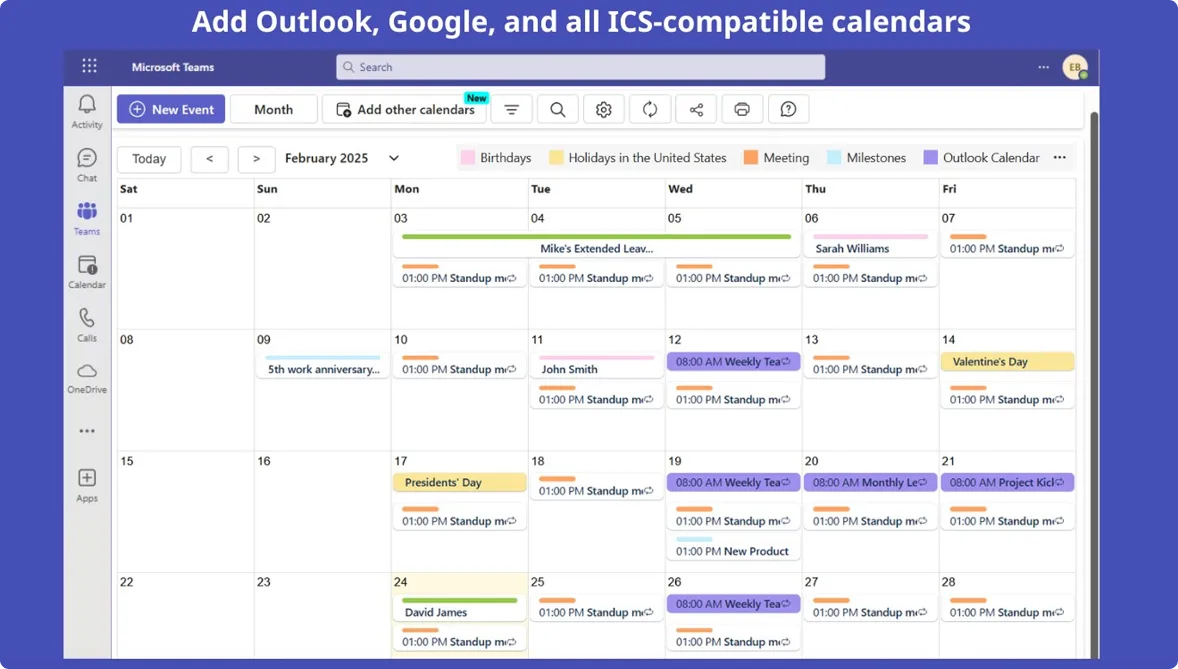
The under-the-radar option that handles Microsoft 365 integration well.
Key features:
- Microsoft 365 integration: Deep integration with existing Microsoft tools
- Resource booking Teams: Resource Booking – Manage meeting rooms & shared assets efficiently
- Team collaboration: Built for collaborative scheduling scenarios
SMB use scenarios:
- Resource management: Project Deadlines – Track milestones & due dates with ease
- Department coordination: Department Coordination – Sync schedules across departments without confusion
Limitations:
- Limited market presence: Less established than competitors
- Feature documentation: Fewer resources and community support
Pricing: Just $99 per calendar/year
Best for: Budget-conscious SMBs needing reliable Microsoft 365-integrated scheduling
👉 Learn more about Avista here: Shared Team Calendar AppSource
Solutions2Share Teams Calendar by Solutions2Share GmbH
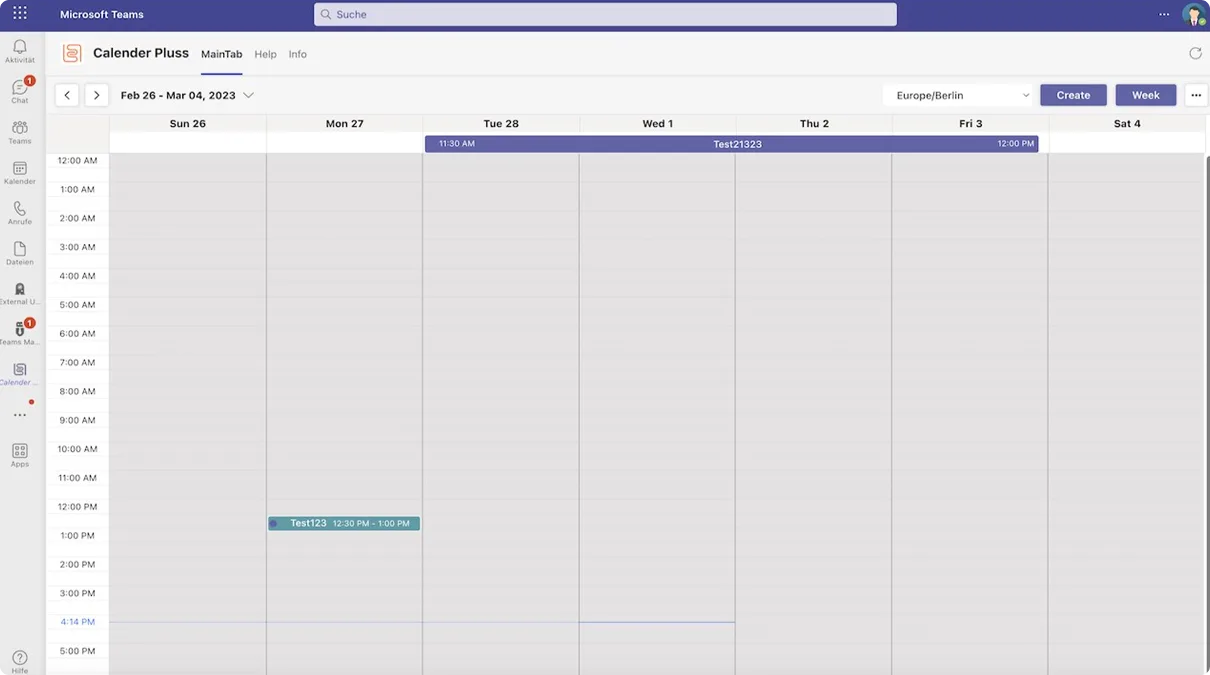
The enterprise-grade option for SMBs with complex needs.
Key features:
- Advanced scheduling: Enterprise-level scheduling capabilities
- SharePoint integration: Deep SharePoint and Teams integration
- Resource management: Comprehensive resource booking and management
SMB use scenarios:
- Complex organizations: SMBs with enterprise-like scheduling requirements
- SharePoint-heavy workflows: Teams already invested in SharePoint ecosystems
Limitations:
- Complexity: May be overkill for simpler SMB needs
- Higher learning curve: Requires more technical expertise
Pricing: Enterprise pricing model
Best for: Larger SMBs or growing companies that need enterprise-grade scheduling capabilities
👉 Learn more about Solutions2Share calendar here: Calendar+ AppSource
Each of these solutions solves different problems for different types of small businesses. The key is matching your specific needs—whether that’s external client coordination, resource management, or simple team scheduling—with the right tool for the job.
| App name | Company | Features & benefits |
| Microsoft Teams Native Calendar | Microsoft | Unified with Outlook, Copilot AI scheduling, delegate access, print, mobile support |
| Virto Shared Calendar | VirtoSoftware | Simple shared calendar for Teams, fast setup, color-coding, recurring events, anonymous sharing, ideal for cross-team scheduling and sharing with external partners |
| Shared Calendar for Microsoft Teams | Cherryware GmbH | Multiple calendar views, color-coding, easy sharing, mobile access, free for small teams |
| Calendar Pro | Witivio | Resource booking, permissions, Power Automate integration, recurring events |
| Channel Calendar (Teams Store) | Microsoft | Dedicated channel calendars for project or department scheduling |
| Calendly for Microsoft Teams | Calendly, LLC | Automates meeting scheduling, integrates with Teams/Outlook, ideal for client appointments |
| CalendarBridge | CalendarBridge, Inc. | Syncs multiple calendars (Outlook, Google), cross-platform integration |
| Teamup Calendar | Teamup Solutions AG | Simple shared calendar, color-coded events, easy external sharing |
| Avista Shared Calendar | Avista Solutions | Resource booking, team collaboration, integrates with Microsoft 365 |
| Solutions2Share Teams Calendar | Solutions2Share GmbH | Advanced scheduling, resource management, SharePoint/Teams integration |
👉What’s the best Teams calendar for collaboration? Virto Shared Calendar stands out as the top choice for collaborative Teams calendaring because it enables seamless sharing with both internal team members and external partners without requiring Microsoft accounts. Its anonymous access feature means you can share project timelines with clients, coordinate with vendors, and keep remote teams synchronized regardless of their technical setup. The real-time sync ensures everyone stays updated instantly, while the simple interface means no training is required for team members or external collaborators. Unlike other solutions that complicate collaboration with complex permission structures or account requirements, Virto Shared Calendar focuses on making cross-organizational collaboration effortless. For teams that regularly work with external stakeholders, this combination of simplicity and universal access makes it unmatched for collaborative scheduling.
Choosing the Right Business Calendar in Teams
Here’s where the rubber meets the road. You’ve seen what’s available, but how do you actually pick the right calendar solution for your specific business? The truth is, there’s no one-size-fits-all answer—it all depends on your team’s workflow, who you’re coordinating with, and what kind of complexity you can handle (or want to avoid).
We’ll walk through the most common SMB scenarios and match them with the calendar solutions that actually work in the real world. Think of this as your decision tree for cutting through the noise and finding the tool that’ll make your scheduling headaches disappear.
For basic internal scheduling: Stick with native Teams calendar
Use the native Teams calendar when your primary need is straightforward internal coordination with the Microsoft 365 tools you’re already using. The new Teams calendar delivers unified scheduling, Copilot-powered insights, and seamless Outlook integration that’s ideal for basic internal meetings and team management.
This is your best bet if you’re mostly scheduling internal team meetings, managing basic project timelines, and coordinating with colleagues who all live in the Microsoft ecosystem. The Copilot integration can suggest optimal meeting times, and the Places features help hybrid teams figure out when to be in the office together.
Perfect for: Traditional office environments, teams that rarely work with external partners, and SMBs that want to keep things simple.
When simplicity and external collaboration matter: Choose Virto Shared Calendar
Select Virto Shared Calendar if your SMB needs a lightweight, intuitive shared calendar that enables quick event creation, color-coding, and tagging for clear visual organization. Here’s what makes it different: Virto Shared Calendar is especially valuable for teams looking for minimal setup, fast onboarding, and a solution that doesn’t require complex integrations or overlays.
Unlike other solutions that try to do everything, Virto Shared Calendar focuses on doing the essentials really well. You can have someone creating and sharing events within minutes of installation—no training sessions, no complex permission setups, no wrestling with overlay configurations.
Perfect for: Fast-moving teams, startups, and any SMB that values “it just works” over feature complexity.
For client-facing businesses: Leverage Virto Shared Calendar’s anonymous access
Leverage Virto Shared Calendar to share schedules easily with external partners, clients, or guests—even those without Microsoft accounts—thanks to its anonymous access and cross-platform availability in Teams, Outlook, and web browsers. This makes it ideal for client-facing roles, project managers, and remote teams who need to centralize schedules across organizational boundaries.
This is where Virto really shines compared to other Teams calendar solutions. While most tools require everyone to have Microsoft accounts or go through complex invitation processes, Virto lets you share a calendar link with anyone. Your client can view your project timeline, your contractor can see availability, and your remote team can stay synchronized—all without creating new accounts or jumping through hoops.
Perfect for: Consultants, agencies, project-based businesses, and any SMB that regularly coordinates with external stakeholders.
For teams prioritizing security and control: Trust Virto Shared Calendar’s permissions
Choose Virto Shared Calendar for scenarios where secure, granular permissions and effortless sharing are priorities. Its real-time sync and simple interface keep your team up to date without a steep learning curve, making it perfect for SMBs that value productivity and accessibility.
You get enterprise-grade security with Microsoft 365-level encryption and compliance standards when sharing within your organization, but you maintain the flexibility to share specific calendars externally when needed. The permissions are granular enough to give different team members different levels of access, but simple enough that you don’t need an IT degree to configure them.
Perfect for: SMBs handling sensitive client information, teams with mixed internal/external collaboration needs, and businesses that need audit trails.
Explore Other Use Cases Where VirtoSoftware Shines
For cross-tenant collaboration: Virto Shared Calendar bridges organizations
Consider Virto Shared Calendar when your SMB works with multiple partners or clients across different Microsoft 365 tenants, as its cross-tenant sharing and anonymous access streamline cooperation between organizations.
This solves a huge pain point for many SMBs. If you’re working with clients who have their own Microsoft 365 setups, or partnering with other businesses, coordinating calendars across different organizational boundaries usually involves email chains, phone calls, or clunky workarounds. Virto Shared Calendar’s cross-tenant sharing means you can collaborate seamlessly regardless of which Microsoft 365 tenant someone belongs to.
Perfect for: B2B service providers, partnership-heavy businesses, and SMBs that frequently collaborate with other organizations.
For advanced visual organization: Consider Cherryware or Teamup
Opt for Shared Calendar for Microsoft Teams (Cherryware) or Teamup Calendar if your business needs flexible calendar views, color-coding, and easy sharing with both internal and external collaborators.
These solutions offer more sophisticated viewing options and organizational tools than simpler alternatives. Cherryware gives you the convenience of staying within Teams while adding timeline views and advanced color-coding. Teamup provides even more flexibility with 11 different calendar views and highly customizable permission structures.
Perfect for: Creative agencies, event planners, and teams that need to visualize complex schedules in multiple ways.
For serious resource management: Go with Calendar Pro or Avista
Choose Calendar Pro (Witivio) or Avista Shared Calendar if you require advanced resource booking, permissions management, or workflow automation.
When you need to manage meeting rooms, equipment, vehicles, or other shared resources with complex booking rules, these solutions provide the depth you need. Calendar Pro’s Power Automate integration lets you create sophisticated workflows, while both options handle resource conflicts and booking approvals much better than simpler alternatives.
Perfect for: Manufacturing SMBs, medical practices, educational institutions, and any business with significant shared resources to manage.
For project-specific organization: Use Channel Calendar
Use Channel Calendar for channel-specific scheduling, especially for project-based or departmental teams.
This makes sense when you want project calendars that live alongside project discussions and files. Each Teams channel gets its own calendar, keeping project scheduling contained and relevant. It’s Microsoft’s attempt at project-based calendar organization, and it works well for teams that organize their work around specific projects or departments.
Perfect for: Project-based businesses, consulting firms, and organizations with clear departmental boundaries.
For professional client booking: Leverage Calendly
Leverage Calendly for automating client appointments and external meeting scheduling.
When your business revolves around booking appointments with clients—whether that’s sales calls, consultations, or service appointments—Calendly’s automation and professional presentation are hard to beat. The Teams integration ensures your meetings automatically include video conferencing links.
Perfect for: Sales teams, consultants, service providers, and any business where client appointment booking is a regular activity.
For multi-platform synchronization: consider CalendarBridge
Consider CalendarBridge if your SMB needs to sync multiple calendars across platforms (e.g., Outlook and Google).
This becomes essential when your team or clients use a mix of calendar platforms. Some people prefer Google Calendar, others live in Outlook, and you need everything to stay synchronized. CalendarBridge handles the complexity of keeping multiple calendar systems updated.
Perfect for: Multi-platform organizations, businesses with diverse client bases, and teams transitioning between calendar systems.
For enterprise-grade complexity: Use Solutions2Share
Use Solutions2Share Teams Calendar for advanced scheduling and resource management, particularly if your business also relies on SharePoint.
This is the option for SMBs that have enterprise-like requirements but aren’t quite enterprise-sized yet. If you’re already invested in SharePoint workflows and need sophisticated scheduling capabilities that integrate deeply with your existing Microsoft infrastructure, this delivers enterprise functionality at SMB scale.
Perfect for: Growing SMBs with complex workflows, SharePoint-heavy organizations, and businesses preparing to scale to enterprise size.
| Your business scenario | Recommended solution | Why this works | Best for |
| Basic internal scheduling | Native Teams calendar | Unified Outlook integration, Copilot insights, seamless Microsoft 365 experience | Traditional offices, internal-focused teams, simple coordination needs |
| Simple external collaboration | Virto Shared Calendar | Lightweight setup, quick onboarding, no complex integrations required | Fast-moving teams, startups, businesses prioritizing simplicity |
| Client-facing operations | Virto Shared Calendar | Anonymous access, cross-platform availability, no Microsoft account required for guests | Consultants, agencies, project managers, client-focused SMBs |
| Security & permission control | Virto Shared Calendar | Granular permissions, real-time sync, enterprise-grade security with simple interface | SMBs handling sensitive data, mixed collaboration needs |
| Cross-tenant collaboration | Virto Shared Calendar | Cross-organizational sharing, anonymous access across different Microsoft 365 tenants | B2B services, partnership-heavy businesses, multi-org collaboration |
| Advanced visual organization | Cherryware Shared Calendar or Teamup | Flexible calendar views, sophisticated color-coding, multiple display options | Creative agencies, event planners, complex schedule visualization |
| Resource management | Calendar Pro or Avista Shared Calendar | Advanced booking features, workflow automation, resource conflict management | Manufacturing, medical practices, equipment-heavy businesses |
| Project-specific scheduling | Channel Calendar | Channel-integrated calendars, project-contained scheduling, departmental organization | Project-based firms, consulting, clear departmental boundaries |
| Client appointment booking | Calendly for Teams | Professional automation, client self-service booking, Teams meeting integration | Sales teams, consultants, service appointments |
| Multi-platform synchronization | CalendarBridge | Cross-platform calendar sync, handles mixed Google/Outlook environments | Multi-platform teams, diverse client bases, system transitions |
| Enterprise-grade features | Solutions2Share Teams Calendar | Advanced scheduling, deep SharePoint integration, enterprise functionality | Growing SMBs, SharePoint-heavy workflows, scaling businesses |
The bottom line: For most SMBs, the choice comes down to whether you need basic internal scheduling (stick with native Teams calendar), simple but powerful external collaboration (choose Virto Shared Calendar), or specialized features like resource booking (go with Calendar Pro) or client appointment automation (leverage Calendly). Virto Shared Calendar hits the sweet spot for teams that need more than basic internal scheduling but don’t want the complexity of enterprise-grade solutions.
👉 What’s the best Teams calendar for small business? For small businesses, Virto Shared Calendar offers the ideal balance of functionality, simplicity, and affordability that SMBs actually need. At $15 per month for teams under 20 users, it provides enterprise-grade features without enterprise complexity or pricing. The lightweight design means quick setup and fast onboarding, while the cross-platform availability ensures it works whether your team is in Teams, on the web, or mobile. Most importantly, its anonymous sharing capability solves the common SMB challenge of coordinating with clients, contractors, and partners who don’t have Microsoft accounts. This makes it perfect for the collaborative, client-facing nature of most small businesses.
Conclusion on Teams Calendar for Business
Microsoft Teams’ new calendar offers improved scheduling and integration for SMBs, but many organizations benefit from third-party apps that provide enhanced sharing, resource booking, and multi-calendar management. Whether your business needs a simple shared calendar, advanced resource management, or seamless integration with external platforms, there’s a Teams calendar solution to fit every SMB need in 2025.
The landscape has never been better for small businesses looking to get their scheduling act together. The native Teams calendar improvements are genuinely useful, especially if you’re already living in the Microsoft ecosystem and your scheduling needs are straightforward. But here’s what we’ve learned from talking to hundreds of SMBs: the real magic happens when you find a calendar solution that actually matches how your business works, not how Microsoft thinks it should work.
For teams that need to collaborate beyond their organizational walls—whether that’s coordinating with clients, managing external contractors, or just making it easy for anyone to see when you’re available—the anonymous access and cross-platform capabilities of tools like Virto Shared Calendar are game-changers. No more email chains trying to find a meeting time. No more forcing clients to create Microsoft accounts just to see your project timeline.
We invite you to try Virto Shared Calendar and discover how anonymous sharing and cross-platform collaboration can transform the way your team coordinates with clients and partners. Set up your first shared calendar in under 5 minutes. Have questions? Talk to our team to discuss your specific scheduling needs and see if Virto Shared Calendar is the right fit for your business.
The key is being honest about what you actually need versus what sounds impressive in a feature list. Most SMBs are better served by a calendar solution that does the essentials really well rather than one that tries to be everything to everyone. Your time is too valuable to spend wrestling with overly complex calendar software.
Whatever direction you choose, the investment in getting your team’s scheduling sorted pays dividends immediately. When everyone knows when everyone else is available, when clients can easily coordinate with your team, and when booking resources doesn’t require a degree in project management—that’s when your business starts running like the well-oiled machine you always knew it could be.

